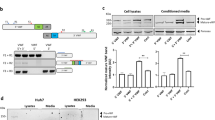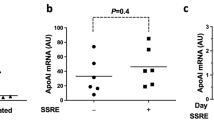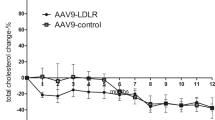Abstract
A major focus in gene therapy has been the use of recombinant viruses to deliver genes in vivo. Although this approach shows much promise, there are many safety concerns associated with the use of viral materials in the treatment of human diseases. Our alternative cell-based gene therapy approach utilizes endothelial cells (Pro 175) isolated from the murine embryonic yolk sac. These endothelial cells were evaluated for their potential use in gene therapy as a gene delivery platform. As a test model, we used these cells to deliver apolipoprotein E (apoE) in the murine apoE knockout atherosclerosis model. The lack of apoE protein in these animals results in high levels of serum cholesterol and formation of severe aortic plaques and lesions at a young age. After transplantation of the apoE secreting Pro 175 endothelial cells into apoE-deficient mice, serum cholesterol levels were measured at 2 week intervals. During the 3 months after the initiation of these experiments, levels of cholesterol in the animals having received the apoE secreting endothelial cells were statistically lower compared with the levels of age-matched controls having received non-secreting endothelial cells. Concomitant with cholesterol reduction, atherosclerotic aortic plaques were noticeably reduced in the experimental apoE+ animals. These results highlight the potential of these unique endothelial cells as an efficient delivery platform for somatic gene therapy.
This is a preview of subscription content, access via your institution
Access options
Subscribe to this journal
Receive 12 print issues and online access
$259.00 per year
only $21.58 per issue
Buy this article
- Purchase on Springer Link
- Instant access to full article PDF
Prices may be subject to local taxes which are calculated during checkout



Similar content being viewed by others

References
Wei Y, Quertermous T, Wagner TE . Directed endothelial differentiation of cultured embryonic yolk sac cells in vivo provides a novel cell-based system for gene therapy Stem Cells (Dayt) 1995 13: 541–547
St Louis D, Verma IM . An alternative approach to somatic cell gene therapy Proc Natl Acad Sci USA 1988 85: 3150–3154
Palmer TD et al. Genetically modified skin fibroblasts persist long after transplantation but gradually inactivate introduced genes Proc Natl Acad Sci USA 1991 88: 1330–1334
Fenjves ES et al. Systemic distribution of apolipoprotein E secreted by grafts of epidermal keratinocytes: implications for epidermal function and gene therapy Proc Natl Acad Sci USA 1989 86: 8803–8807
Morgan RA et al. Retroviral vectors containing putative internal ribosome entry sites: development of a polycistronic gene transfer system and applications to human gene therapy Nucleic Acids Res 1992 20: 1293–1299
Gerrard AJ et al. Towards gene therapy for haemophilia B using primary human keratinocytes Nat Genet 1993 3: 180–183
Smith GH et al. Long-term in vivo expression of genes introduced by retrovirus-mediated transfer into mammary epithelial cells J Virol 1991 65: 6365–6370
Zwiebel JA et al. High-level recombinant gene expression in rabbit endothelial cells transduced by retroviral vectors Science 1989 243: 220–222
Dai Y et al. Gene therapy via primary myoblasts: long-term expression of factor IX protein following transplantation in vivo Proc Natl Acad Sci USA 1992 89: 10892–10895
Lynch CM et al. Long-term expression of human adenosine deaminase in vascular smooth muscle cells of rats: a model for gene therapy Proc Natl Acad Sci USA 1992 89: 1138–1142
Berg R . In: Steunberg, Bearn, Motulsky, Childs (eds). Progress in Medical Genetics Saunders: Philadelphia 1983
Breslow JL . Lipoprotein transport gene abnormalities underlying coronary heart disease susceptibility Annu Rev Med 1991 42: 357–371
Grundy SM . George Lyman Duff Memorial Lecture. Multifactorial etiology of hypercholesterolemia. Implications for prevention of coronary heart disease Arterioscler Thromb 1991 11: 1619–1635
Lusis AJ . Genetic factors affecting blood lipoproteins: the candidate gene approach J Lipid Res 1988 29: 397–429
Getz GS et al. Atherosclerosis and apoprotein E. An enigmatic relationship Arch Pathol Lab Med 1988 112: 1048–1055
Mahley RW et al. Plasma lipoproteins: apolipoprotein structure and function J Lipid Res 1984 25: 1277–1294
Mahley RW . Apolipoprotein E: cholesterol transport protein with expanding role in cell biology Science 1988 240: 622–630
Reue KL et al. Cloning and regulation of messenger RNA for mouse apolipoprotein E J Biol Chem 1984 259: 2100–2107
Zannis VI et al. mRNA and apolipoprotein E synthesis abnormalities in peripheral blood monocyte macrophages in familial apolipoprotein E deficiency J Biol Chem 1985 260: 12891–12894
Williams DL et al. Apolipoprotein E synthesis in peripheral tissues of nonhuman primates J Biol Chem 1985 260: 2444–2451
Driscoll DM, Getz GS . Extrahepatic synthesis of apolipoprotein E J Lipid Res 1984 25: 1368–1379
Mahley RW et al. Cellular and molecular biology of lipoprotein metabolism: characterization of lipoprotein receptor–ligand interactions Cold Spring Harb Symp Quant Biol 1986 51: 821–828
Nykjaer A et al. The alpha 2-macroglobulin receptor/low density lipoprotein receptor-related protein binds lipoprotein lipase and beta-migrating very low density lipoprotein associated with the lipase J Biol Chem 1993 268: 15048–15055
Mulder M et al. Low density lipoprotein receptor internalizes low density and very low density lipoproteins that are bound to heparan sulfate proteoglycans via lipoprotein lipase J Biol Chem 1993 268: 9369–9375
Mahley RW et al. Role of heparan sulfate proteoglycans and the LDL receptor-related protein in remnant lipoprotein metabolism Ann NY Acad Sci 1994 737: 39–52
Santamarina-Fojo S, Dugi KA . Structure, function and role of lipoprotein lipase in lipoprotein metabolism Curr Opin Lipidol 1994 5: 117–125
Takahashi S et al. Rabbit very low density lipoprotein receptor: a low density lipoprotein receptor-like protein with distinct ligand specificity Proc Natl Acad Sci USA 1992 89: 9252–9256
Brown MS, Goldstein JL . A receptor-mediated pathway for cholesterol homeostasis Science 1986 232: 34–47
Mahley RW, Innerarity TL . Lipoprotein receptors and cholesterol homeostasis Biochim Biophys Acta 1983 737: 197–222
Camus MC et al. Distribution and characterization of the serum lipoproteins and apoproteins in the mouse, Mus musculus J Lipid Res 1983 24: 1210–1228
Weibust RS . Inheritance of plasma cholesterol levels in mice Genetics 1973 73: 303–312
Plump AS et al. Severe hypercholesterolemia and atherosclerosis in apolipoprotein E-deficient mice created by homologous recombination in ES cells Cell 1992 71: 343–353
Breslow JL . Transgenic mouse models of lipoprotein metabolism and atherosclerosis Proc Natl Acad Sci USA 1993 90: 8314–8318
Linton MF, Atkinson JB, Fazio S . Prevention of atherosclerosis in apolipoprotein E-deficient mice by bone marrow transplantation Science 1995 267: 1034–1037
Bellosta S et al. Macrophage-specific expression of human apolipoprotein E reduces atherosclerosis in hypercholesterolemic apolipoprotein E-null mice J Clin Invest 1995 96: 2170–2179
Kashyap VS et al. Apolipoprotein E deficiency in mice: gene replacement and prevention of atherosclerosis using adenovirus vectors J Clin Invest 1995 96: 1612–1620
Russi TJ, Hirschowitz EA, Crystal RG . Delayed-type hypersensitivity response to high doses of adenoviral vectors Hum Gene Ther 1997 8: 323–330
Mahley RW et al. Intravenous infusion of apolipoprotein E accelerates clearance of plasma lipoproteins in rabbits J Clin Invest 1989 83: 2125–2130
Shimano H et al. Inhibition of diet-induced atheroma formation in transgenic mice expressing apolipoprotein E in the arterial wall J Clin Invest 1995 95: 469–476
Boisvert WA, Spangenberg J, Curtiss LK . Treatment of severe hypercholesterolemia in apolipoprotein E-deficient mice by bone marrow transplantation J Clin Invest 1995 96: 1118–1124
Wong GH et al. Interferon-gamma induces enhanced expression of Ia and H-2 antigens on B lymphoid, macrophage, and myeloid cell lines J Immunol 1983 131: 788–793
Gretch DG et al. Baculovirus-mediated expression of human apolipoprotein E in Manduca sexta larvae generates particles that bind to the low density lipoprotein receptor Proc Natl Acad Sci USA 1991 88: 8530–8533
Felgner PL et al. Lipofection: a highly efficient, lipid-mediated DNA-transfection procedure Proc Natl Acad Sci USA 1987 84: 7413–7417
Kleinman HK et al. Isolation and characterization of type IV procollagen, laminin, and heparan sulfate proteoglycan from the EHS sarcoma Biochemistry 1982 21: 6188–6193
Allain CC et al. Enzymatic determination of total serum cholesterol Clin Chem 1974 20: 470–475
Cham BE, Knowles BR . A solvent system for delipidation of plasma or serum without protein precipitation J Lipid Res 1976 17: 176–181
Paigen B et al. Quantitative assessment of atherosclerotic lesions in mice Atherosclerosis 1987 68: 231–240
Acknowledgements
The excellent technical assistance of Jay Erisman and Viy McGauhy is gratefully acknowledged. We would like to thank Dr Joseph Cioffi for carefully reviewing the manuscript. We would like to thank Dr Alan Attie for his generous gift of the human apoE3 gene.
Author information
Authors and Affiliations
Rights and permissions
About this article
Cite this article
Cioffi, L., Sturtz, F., Wittmer, S. et al. A novel endothelial cell-based gene therapy platform for the in vivo delivery of apolipoprotein E. Gene Ther 6, 1153–1159 (1999). https://doi.org/10.1038/sj.gt.3300890
Received:
Accepted:
Published:
Issue Date:
DOI: https://doi.org/10.1038/sj.gt.3300890


